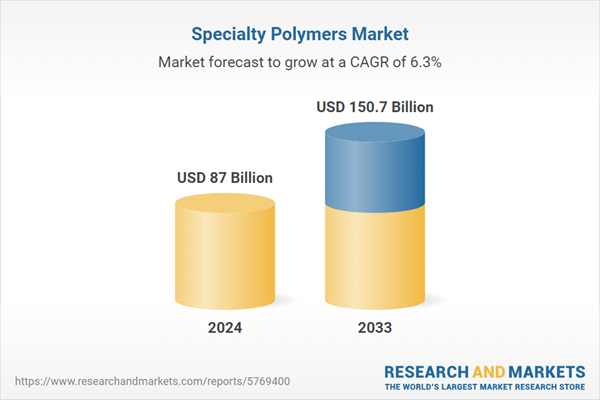Specialty polymers refer to a class of synthetic materials that have been designed and engineered to possess specific properties and functions for a wide range of industrial and commercial applications. These polymers are typically produced by modifying the chemical structure of the base polymer or by blending two or more different polymers to achieve the desired properties. Specialty polymers can exhibit a range of unique characteristics such as high strength, durability, chemical resistance, thermal stability, and electrical conductivity. Some commonly used specialty polymers include thermoplastic elastomers (TPEs), fluoropolymers, liquid crystal polymers (LCPs), high-performance polyamides (HPAs), and polyetheretherketones (PEEKs). Nowadays, the demand for specialty polymers has escalated as these materials are used in numerous applications where traditional polymers are not suitable due to their limitations in terms of performance or processing.
Specialty Polymers Market Trends:
One of the primary factors driving the market is the growing demand from end-use industries, such as automotive, aerospace, electronics, medical, and consumer goods. Additionally, the increasing demand for electric and hybrid vehicles is creating a positive market outlook, as specialty polymers are used to produce high-performance, lightweight components. Other than this, with the growing need for renewable energy sources, such as wind and solar power, specialty polymers are widely used in the production of lightweight and durable components for wind turbines and solar panels. Besides this, specialty polymers find application in 3D printing as they offer superior mechanical properties, which are essential in producing complex and high-performance 3D printed components. In line with this, the demand for eco-friendly and sustainable materials is driving the adoption of biodegradable specialty polymers used in manufacturing biocompatible and high-performance materials. Furthermore, numerous technological advancements are leading to new and innovative specialty polymers with unique properties and applications. Other growth-inducing factors include stringent regulations implemented by numerous governments of various nations, increasing focus on research and development (R&D) activities by key players, and growth of emerging economies on account of their growing industrialization and infrastructure development.Key Market Segmentation:
The publisher provides an analysis of the key trends in each segment of the global specialty polymers market, along with forecasts at the global, regional, and country levels from 2025-2033. Our report has categorized the market based on the product type and end use industry.Product Type Insights:
- Specialty Elastomers
- Fluoroelastomers
- Fluorosilicone Rubber
- Liquid Silicone Rubber
- Natural Rubber
- Others
- Specialty Composites
- Particle Reinforced Composites
- Fiber Reinforced Composites
- Structural Composites
- Specialty Thermoplastics
- Polyolefins
- Polyimides
- Vinyl Polymer
- Polyphenols
- Others
- Specialty Thermosets
- Epoxy
- Polyester
- Vinyl Ester
- Polyimides
- Others
- Others
End Use Industry Insights:
- Automotive and Transportation
- Consumer Goods
- Building and Construction
- Coatings, Adhesives, and Sealants
- Electrical and Electronics
- Healthcare
- Others
Regional Insights:
- North America
- United States
- Canada
- Asia-Pacific
- China
- Japan
- India
- South Korea
- Australia
- Indonesia
- Others
- Europe
- Germany
- France
- United Kingdom
- Italy
- Spain
- Russia
- Others
- Latin America
- Brazil
- Mexico
- Others
- Middle East and Africa
Competitive Landscape:
The report has also provided a comprehensive analysis of the competitive landscape in the specialty polymers market. Competitive analysis such as market structure, market share by key players, player positioning, top winning strategies, competitive dashboard, and company evaluation quadrant has been covered in the report. Also, detailed profiles of all major companies have been provided. Some of the companies covered include 3M Company, A. Schulman Inc. (LyondellBasell Industries N.V.), Arkema S.A., Ashland Inc., Avient Corporation, BASF SE, Croda International Plc, Dow Inc., Evonik Industries AG, Koninklijke DSM N.V., Solvay S.A., Specialty Polymers Inc. (The Sherwin-Williams Company), etc.Key Questions Answered in This Report:
- How has the global specialty polymers market performed so far, and how will it perform in the coming years ?
- What are the drivers, restraints, and opportunities in the global specialty polymers market ?
- What is the impact of each driver, restraint, and opportunity on the global specialty polymers market ?
- What are the key regional markets ?
- Which countries represent the most attractive specialty polymers market ?
- What is the breakup of the market based on the product type ?
- Which is the most attractive product type in the specialty polymers market ?
- What is the breakup of the market based on the end use industry ?
- Which is the most attractive end use industry in the specialty polymers market ?
- What is the competitive structure of the global specialty polymers market ?
- Who are the key players/companies in the global specialty polymers market ?
Table of Contents
Companies Mentioned
- IMARC Group provides an analysis of the key trends in each segment of the global specialty polymers market
- along with forecasts at the global
- regional
- country levels from 2025-2033. Our report has categorized the market based on the product type
- end use industry.
Table Information
| Report Attribute | Details |
|---|---|
| No. of Pages | 144 |
| Published | March 2025 |
| Forecast Period | 2024 - 2033 |
| Estimated Market Value ( USD | $ 87 Billion |
| Forecasted Market Value ( USD | $ 150.7 Billion |
| Compound Annual Growth Rate | 6.3% |
| Regions Covered | Global |
| No. of Companies Mentioned | 4 |









